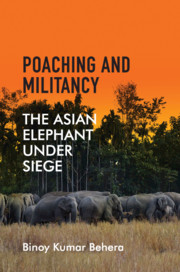1 - The Asian Elephant
Published online by Cambridge University Press: 23 November 2018
Summary
The earliest forms of simple cellular life, prokaryotes, began on earth about 3.6 billion years ago, the earth itself being 4.6 billion years old. Some 1.6 billion years later, complex cellular life, eukaryotes, came into existence and multi-cellular organisms a billion years thence. Simple animals came around 600 million years back, fish and protoamphibians around 500 million years ago, amphibians around 360 million years ago, and reptiles 300 million years back.
Mammals, the category to which both man and elephant belong, came into existence some 200 million years back. Of the ancestry of these two species, the mammoth—from which the elephant has directly descended—appeared 4.8 million years back, while humans—as they anatomically and physically appear—came only 2,00,000 years ago.
In this constant process of evolution, different species have evolved over time through more specialised and efficient bodily attributes to adapt better to their living environment. In the struggle for survival, those species that could not adapt or were slow in adapting to their changing environment were marked out by nature for extinction, sometimes sooner and at times later.
The early forms of life began in water and in course of time developed features that made them more adaptable to their environment. When some moved over to land in due course, the gills or equivalent organs that they used for drawing dissolved oxygen from water gradually transformed into lungs to enable them to breathe directly from the atmosphere. Likewise, when living on land became difficult for some species, sometimes on account of excessive body weight that was difficult to carry around, they moved into water, where its buoyancy helped their mobility. Not surprisingly, the blue whale, the biggest mammal on earth that needs to breathe directly from the atmosphere, is an aquatic animal.
As the need for limbs, like hands and feet or forelegs and hind legs, was not felt in water as it was on land, such limbs gradually disappeared or were modified to form flippers and fins to help in the new living environment. While the internal system of some animals like sharks and crocodiles was already so efficient that there was little need for further evolution, others needed time—thousands of years—to evolve in order to survive in and adapt to the slowly changing environment.
- Type
- Chapter
- Information
- Poaching and MilitancyThe Asian Elephant under Siege, pp. 1 - 15Publisher: Cambridge University PressPrint publication year: 2019

